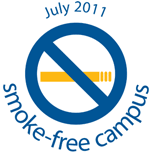Last week Mary Sue Coleman approved the final report on U-M's Smoke-Free policy. Just a reminder, that the UM-Dearborn campus will be smoke-free beginning July 1, 2011. The article below, reprinted from the University Record, provides some key information. The UM-Dearborn Smoke-Free Campus Committee is still finalizing a few policy related items, be on the lookout for further UM-Dearborn implementation communication. For more information visit www.umd.umich.edu/smokefree.
U-M goes smoke-free July 1; policy details finalized
By Laurel Thomas Gnagey
Reprinted with permission from the University Record
President Mary Sue Coleman has approved the final report on implementation of the new smoke-free policy that goes into effect July 1.
The steering committee for the Smoke-free University Initiative 's report includes 14 recommendations that define campus smoke-free boundaries, commit to treatment and support for those who wish to receive assistance to quit, and outline expectations for compliance. Among the recommendations:
- While all U-M facilities, buildings and grounds will be smoke free, smoking will not be prohibited on sidewalks adjacent to public thoroughfares on the Ann Arbor campuses.
- All parking structures and surface lots should be smoke free. This does not include smoking in privately owned vehicles within these locations.
- Peer support, supervisory oversight and voluntary compliance should be relied upon to lead to behavioral changes over time. Smokers refusing to extinguish the product or repeat offenders of the policy should be addressed through existing disciplinary or other appropriate processes.
- U-M should provide resources to support managers, supervisors, students, faculty and staff with methods to address violations in a respectful manner.
- MHealthy and the University Health Service Health Promotion and Community Relations department should support faculty, staff and students in their stop-smoking efforts.
Leaders of the effort say the final plan was crafted after more than a year of extensive input from many in the campus and surrounding community.
"At the outset, we said we wanted to hear from representatives of all members of our community - faculty, staff, students, area residents, smokers, nonsmokers and never smokers - and we did," says Kenneth Warner, former dean of the School of Public Health and the Avedis Donabedian Distinguished University Professor of Public Health. "Five different subcommittees compiled surveys, conducted focus groups, held numerous meetings, and more, to get input from those who would be impacted by this change. The final report is a reflection of the input we received."
 Coleman announced in April 2009 the plan for all three U-M campuses to go smoke free. A target date for implementation was set as July 1, 2011, to allow the subcommittees - facilities, grounds and the Ann Arbor interface; faculty and staff; guests, events and athletics; student life; and communications - the opportunity to gather input and make recommendation to the steering committee. It also allowed time for each campus to develop its own implementation plan.
Coleman announced in April 2009 the plan for all three U-M campuses to go smoke free. A target date for implementation was set as July 1, 2011, to allow the subcommittees - facilities, grounds and the Ann Arbor interface; faculty and staff; guests, events and athletics; student life; and communications - the opportunity to gather input and make recommendation to the steering committee. It also allowed time for each campus to develop its own implementation plan.
"We were very pleased that so many in the university took the time to express their opinions, ask thoughtful questions and challenge the steering committee to come up with a policy that considers the impact on all of its constituents. We also are grateful to the many people who spent numerous hours working on the five subcommittees," says Dr. Robert Winfield, U-M's chief health officer and director of University Health Service. "We are confident that with all of this great input we have a policy that achieves our goal of promoting a healthy campus while being as respectful as possible to the needs and concerns of all in our community."
One of the questions heard most often from the various groups was about how boundaries would be defined. While the report calls for all university facilities, buildings and grounds, including athletic properties, to be smoke-free, it makes two exceptions: smoking inside personal vehicles and along main thoroughfares. The ban does not include smokeless tobacco products.
The steering committee recommendation that smoking should not be prohibited along public thoroughfares was a decision based on the fact that the streets are not university-owned and, therefore, U-M has no authority over the adjacent sidewalks. To be consistent, it also treated the sidewalks along major roads on North Campus - which are university-owned - as areas outside of the smoking ban. Sidewalks within a campus area, such as the Diag, however, will be smoke free. Some signage, website maps and the presence of smoking receptacles in those places that are not included in the ban will help define the areas, leaders say.
In order to keep people from having to walk through smoke-filled areas, the ban also included sections of sidewalk adjacent to access drives, loading docks, parking structures, parking lots or along driveways - even if these areas are along major thoroughfares.
A second question frequently asked by students, faculty and staff was how the policy would be enforced.
"This was carefully considered by the group and it was decided that we would rely on voluntary compliance, along with peer and supervisory support, rather than fines or other means of enforcement," says Laurita Thomas, associate vice president for human resources.
The smoke-free policy will be included in the university's Standard Practice Guide, which outlines disciplinary procedures for staff who violate any university policy. Student-related smoking violations would get directed to the Office of Student Conflict Resolution, which handles issues involving student conduct.
Thomas says the steering committee heard from a number of supervisors who were concerned about what they should do when faced with violators. The team is in the process of sharing the final report with the supervisors, and will equip them with information that will assist in helping others adapt to the new policy, she says.
According to surveys, students (both smokers and nonsmokers) were most concerned about the rights and accountability of their peers. While 45.4 percent of students indicated that the initiative would affect them "slightly" or "not at all," 21.5 percent indicated that the initiative would affect them "a great deal." All of these populations were concerned that smokers and nonsmokers alike be treated with respect and fairness.
Another key recommendation in the plan called for MHealthy and the University Health Service Health Promotion and Community Relations department to support faculty, staff and students who want to stop smoking and wish to receive assistance. Shortly after the smoke-free campus announcement was made, both programs announced a number of incentives and services for those who wanted to take the campus ban as an opportunity to quit.
Faculty, staff and their spouses or other qualified adults can receive free smoking-cessation counseling, use of Web or phone assistance smoking-cessation programs, and the inclusion of generic over-the-counter nicotine replacement products in the Tier 1 pharmacy benefit. They also can count participation in a quit program toward a $100 MHealthy incentive. Similarly, UHS has offered students free quit classes, counseling and over the counter nicotine replacement products when enrolled in a counseling program, along with discounted smoking-cessation prescription products.
The plan also lays out some communication goals to make sure students, faculty, staff and visitors are aware of the change. Communication through recruitment and orientation channels (faculty, staff and student), promotional materials provided to visitors, and outreach via campus and external media has been under way since shortly after the announcement of a smoke-free campus was made. Last week, materials targeted at students - which received student feedback prior to final approval - were distributed widely across campus. A similar awareness campaign to launch in February is planned for faculty and staff.
The final recommendations in the report charge the Tobacco Consultation Service with day-to-day management and monitoring of the policy, and call for an advisory committee to assist the chief health officer in evaluating any recommended changes to it, should any be suggested over time.
In 1987 U-M first adopted a universitywide ban on smoking in buildings (except several designated residence halls) and university vehicles. In 1998 the Health System prohibited smoking on the grounds and in public spaces. In 2003 the Residence Hall Association eliminated smoking from all residence halls.





